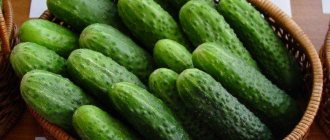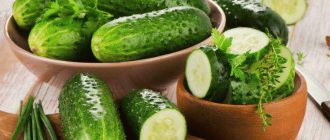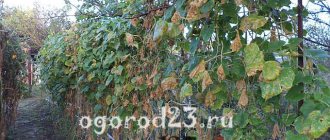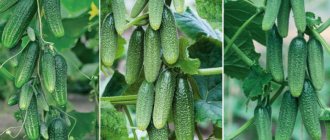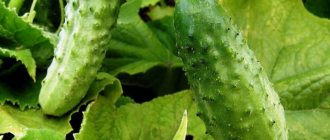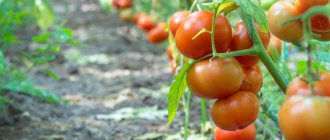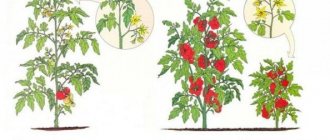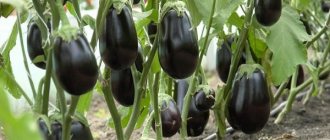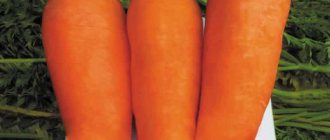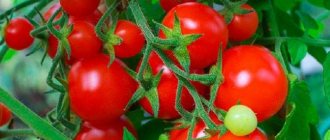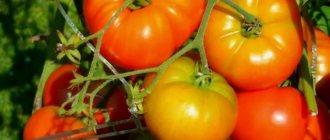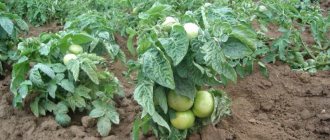Reasons for prolonged fruiting
Productivity plays a special role for a gardener, especially if growing cucumbers is an additional income for the family. The duration of fruiting of cucumbers is influenced by many aspects. The soil must be properly selected, fertile and fertilized. To enrich the soil with nutrients, manure is used, which should be dug up with the soil about three weeks before planting the plants in the greenhouse.
It is necessary to strictly observe the timing of applying fertilizers and planting seedlings. Otherwise, the seedlings may die from an excess of ammonia in the soil.
The most optimal soil mixture for cucumbers is:
- 45% peat;
- 25% humus;
- 30% garden land;
- some rotted sawdust and coniferous wood.
Long-term fruiting depends on the variety of cucumbers, so for a good harvest it is better to sow hybrids that have been specially sectioned.
Cucumbers will bear fruit for a long time if the greenhouse design is chosen correctly. The best option would be to build a polycarbonate or glass structure on the site. If the greenhouse is covered with a thick layer of polycarbonate, it has heating and a lighting system, then you can harvest cucumbers even in winter.
Feeding is another factor influencing the duration of fruiting. Typically, cucumbers planted in a greenhouse are fertilized three times per season. During a long growing season, the amount of root and basal fertilizing should be increased by 1-2 times.
As for hybrids with a long fruiting period:
- As soon as the first harvest is harvested from the main vine, lateral layers begin to grow rapidly and develop with a large production of fruits.
- In closed ground conditions, in such varieties, cuttings can grow from each internode, and it is necessary to remove the excess ones, forming a bush.
- There are certain hybrids that not only branch well, but also regulate the appearance of layering on their own.
- This is due to the fact that until the first harvest is harvested from the main stem, the lateral layers do not begin to grow. This is very convenient for those who cannot come to their summer cottage very rarely, for example once a week on the weekend.
If there is no heating in the greenhouse, then you can get a long harvest from cold-resistant and shade-tolerant cucumber varieties.
But not only the variety of cucumbers affects the duration of fruiting; there are also other factors:
- timely and abundant watering;
- optimal growing conditions, which are easier to create indoors;
- timely feeding;
- plenty of sunlight;
- correct bush formation and garter.
Even if hybrids with a long fruiting period are planted in a greenhouse, but the growing conditions are not met, then you will not be able to get a long and good harvest; cucumbers are a heat-loving plant.
Agronomic requirements for growing cucumbers
It is better to sow climbing varieties of cucumbers with a large number of side shoots in open ground. Bushy and compact varieties are better suited for greenhouses. By following these tips, you can get high yields from your garden beds.
Success in growing crops also depends on the following factors:
- temperature regime;
- illumination;
- watering;
- fertilizers;
- varieties and hybrids.
Temperature
Cucumbers are a heat-demanding crop. A decrease in temperature to +15 °C leads to a cessation of seedling growth; when it drops to +12 °C and below, the plants often die. Night temperature changes during fruit set lead to the development of deformed specimens. For the same reason, cucumbers lose productivity. The optimal time for sowing seeds in unprotected soil is the end of May, the beginning of June. During this period, the soil warms up to +15 °C, the air - to +22...+28 °C. The night temperature does not fall below +12…+16 °C.
Sowing dates for mid-season and late varieties are May - June. At this time, the temperature regime of the air in the upper ball of the soil is normalized, which is very important for mid-ripening varieties, and allows seedlings of late-ripening varieties and hybrids to develop normally.
Illumination
The culture loves light, so cucumbers are grown in open, well-lit areas. Cucumbers don't like being cramped. The distance between two sprouts is about 20 cm. Cucumbers are short-day plants. This indicator affects the yield of varieties. A larger harvest is harvested from late and mid-ripening cucumbers than from early-ripening ones. For rapid growth of the crop, 10–12 hours of daylight is enough.
Watering
Insufficient watering of cucumbers leads to darkening and brittleness of the leaves. Excess moisture is also contraindicated for this crop. Over-wetting the soil reduces the amount of oxygen in it. Which leads to deterioration in the development of stems and a decrease in the yield of bushes. The leaves turn pale. For irrigation, take water at a temperature of +18 °C, since watering with cold water impairs the ability of cucumber roots to absorb water.
Fertilizer application
The first time fertilizer is applied before sowing the seeds. The top layer of soil is fertilized with bird droppings, manure or mullein. The added organic matter is sufficient for the growth of cucumbers and increases the protective properties of seedlings against diseases. Fertilizing with a mixture of nitrogen, phosphorus and potassium fertilizers is done with the appearance of the first shoots.
Important: the use of horse manure for feeding cucumbers in open ground is contraindicated. Manure contains a high percentage of ammonia. It enters into chemical reactions with the soil, as a result of which nitrates accumulate in the fruits. This leads to poisoning of a person after eating cucumbers.
Among the huge number of varieties and hybrids, it is sometimes difficult to choose suitable cucumber seeds. Many gardeners, especially beginners, buy them after reading the information on the back of the package. This approach often leads to disastrous results: money is wasted, there are no or few shoots, pickled cucumbers turn out soft and tasteless.
The varieties and hybrids described below have been tested by many vegetable growers. They are sown directly into the ground and produce high yields. The fruits have a pronounced cucumber taste.
Overview of varieties
Let's look at the most common and popular varieties of cucumbers with long-term fruiting, which gardeners often plant in greenhouses. We present to you the best varieties of cucumbers for the greenhouse!
Anyuta F1
Self-pollinating, bouquet variety.
- Up to 5 greens can be formed in one inflorescence.
- Can be used both for fresh food and for winter preparations.
- It has high resistance to many diseases.
The color of the fruit is emerald with small tubercles and white spines, with high taste.
Buyan F1
Early ripe gherkin. The type of inflorescences is bouquet, can form up to 6 ovaries. Cucumbers are cylindrical in shape, universally used, with small tubercles with small thorns.
The variety is self-pollinating, which makes it indispensable for cultivation in closed ground conditions. Resistant to diseases, with good taste, the variety has a rich vitamin composition in the fruits.
Virenta F1
The variety can be safely planted in unheated greenhouses and still get a long harvest, as it is not afraid of temperature changes. A self-pollinating plant with a long fruiting period and resistance to many diseases. The variety is universal and can quickly adapt to any growing conditions. The cucumber has tubercles with white spines.
Asshole F1
Early ripening, self-pollinating variety.
- The fruits are tied in bunches of 6 pieces.
- The main stem is very powerful, grows quickly, side shoots are formed in moderate quantities.
The variety is shade-tolerant, can easily tolerate low temperatures, and is resistant to many diseases. The cucumbers are cylindrical in shape with tubercles and black spines that are very sparsely spaced. The hybrid has no natural bitterness, the fruits are juicy and tasty.
Lord F1
An early variety that will produce the first harvest 45 days after sowing the seeds, it is cold-resistant, versatile, and has a long fruiting period. A fruit with high taste.
Bunch varieties of long-term fruiting for growing in open ground
Typically, pollinated varieties of cucumbers are grown in the garden, but seeds of self-pollinating bunch cucumbers can also be planted in open ground. This variety of vegetable crop is characterized by rapid fruiting.
After the seeds have sprouted, in the first stages it is better to keep the bushes under a film cover. This will significantly speed up fruiting. As soon as the first ovaries appear, the shelter must be removed.
The best and most popular varieties and hybrids of self-pollinating long-bearing cucumbers for open ground include the following varieties.
Prestige F1
It is a mid-early hybrid with fruiting already 1.5 months after the appearance of the first shoots. Seeds are the development of domestic specialists. Fruits 3-4 greens in one ovary. Productivity - up to 25 kg per square meter.
The advantage of cucumbers is that their fruiting is long and lasts until frost.
Mainly used for making salad.
Beam splendor F1
This variety is the best option for growing in the Urals and Siberia. High-yielding cucumber with early seed germination. If you care for it properly, you can collect several hundred fruits from one bush.
Among the advantages of Tufted Splendor is the variety’s resistance to temperature changes, diseases and other unfavorable environmental factors, as well as a long fruiting period.
One bunch can contain up to 7 greens.
Ginga F1
German hybrid with a yield of up to 6 kg per square meter. Resistant to major cucumber diseases. The fruits are medium, not bitter.
The first greens appear on the bushes 40–50 days after the seeds hatch on the surface.
Okhotny Ryad F1
It is distinguished by short, pimply fruits with good taste. Greens are not bitter and can be used both for salads and for preservation.
Okhotny Row F1 shows the best results when grown from seedlings. Up to 6 cucumbers are formed in one bouquet.
This is a very early variety (the seeds appear a little more than a month after sowing). There is only one drawback - susceptibility to the disease "downy mildew".
Gunnar F1
Suitable for open ground cultivation in the southern regions. The greens are dark, gherkin-type, and have excellent taste.
This cucumber shows amazing productivity - up to 20 kg per square meter.
Moreover, before the first fruits appear, usually no more than 40 days pass after seed germination.
Gunnar F1 is slightly susceptible to the main cucumber fungal diseases: mosaic, cladosporiosis and powdery mildew.
Video
You can also watch a video where an experienced gardener will tell you which varieties of cucumbers are the best in the field of long-term fruiting.
In closed ground conditions, you can get a long and good harvest of cucumbers if you choose the right seed material and provide proper care.
Every person who grows garden crops tries to get a high-quality harvest, apply the best technology, and introduce a new product. Cucumbers are no exception. Among several varieties, self-pollinating varieties of cucumbers should be highlighted.
As practice shows, these cucumbers do not require special care. It is enough just to provide them with good air humidity, access to plenty of sunlight and nutritious soil. That is why self-pollinating cucumbers began to be found more often on closed garden farms.
What are self-pollinating cucumber varieties? The clue is in the name itself. The peculiarity of these cucumbers lies in the structure of their body - they have both a pistil (male component) and a stamen (female component) in one flower. The presence of such a structure implies the process of self-pollination, independently creating fruits with seeds.
The difference between mid-season and late varieties
In recent years, breeders have been delighting gardeners with an abundance of early and super-early ripening hybrids. But at the same time, the number of mid-season and late types of cucumbers does not decrease. New gardeners are often at a loss as to which varieties to choose. After all, if fruits appear on early hybrids in 3–4 weeks, then why are there so many seeds of late-ripening species on sale?
This is due to the result that the grower receives during the season. If we turn to the basics of botany, we can find out that in the first phase, the cucumber builds up its root system. Although it is not very large, before the first buds appear, the plant spends all its energy on growing roots. During the period of budding and the appearance of the first flowers and the first ovary, cucumbers intensively increase the ground part.
Experienced users plant several bushes of early and super early varieties of cucumbers. The main plantings are allocated to mid-season and late hybrids. Late cucumbers have a long period of fruiting and are suitable for pickling, pickling and canning. During the entire ripening period they are consumed fresh. They are frozen to be used in the winter for cold soups and okroshkas.
Like late, mid-ripening varieties belong to the universal species. They are good for fresh consumption and suitable for winter preparations.
The difference between mid-season and late varieties is in the timing of ripening. And the main difference between mid-season cucumbers is their resistance to all diseases characteristic of this crop.
For late varieties, breeders have focused on hardening the plants, since the temperature drops during their ripening, especially at night. Many varieties and hybrids bear fruit until October.
Self-pollinating varieties of cucumbers - concept and advantages
Very often, the term self-pollinating refers to varieties of cucumbers that do not require pollination by bees or other plants. Actually this is not true. Two varieties of cucumbers do not require the participation of bees or other insects in the formation of fruits, namely:
parthencarpic varieties of cucumbers (self-fertile). They do not need pollination at all, so their fruits do not contain seeds;
self-pollinating varieties of cucumbers. They have both pistil and stamens in their flowers, that is, they are absolutely self-sufficient. The pollination process occurs within one plant, and the fruits, which is completely natural, have seeds.
Parthenocarpic and self-pollinating varieties are largely similar in terms of the techniques and agricultural techniques used in their cultivation, as well as the advantages they have.
What are the advantages of these varieties of cucumbers, due to the presence of which they have become so widespread?
Firstly, these varieties are ideal for growing in greenhouses and greenhouses, where it is not always possible to provide free access to bees. This greatly simplifies their cultivation compared to bee-pollinated varieties, since there is no need to specially attract insects.
Secondly, and this is more important for the topic of this article, parthenocarpic and self-pollinating varieties are best suited for open ground in central Russia and even more northern regions of the country. The fact is that the number of sunny and warm days, when bees are most active, is small in these regions. Therefore, an important advantage is the possibility of fruiting on cold and cloudy days. This is precisely what distinguishes self-pollinating varieties of cucumbers, which have long been recognized as the best for central Russia.
Cucumber seeds: proper preparation of cucumber seeds and growing features
To avoid problems with growing crops, so that all the work is not in vain, and it is of high quality and rich, you should take a responsible approach to the choice of varieties and hybrids. Is the variety you like suitable for the conditions that will be provided to it? Very often, gardeners sow varieties that are intended for planting in a greenhouse directly into open ground and are left disappointed. If there are no shoots, you should not blame the manufacturer - you should carefully study the recommendations on the bag.
The best cucumber seeds in the photo for open ground and greenhouses
You can select the best cucumber seeds that will delight gardeners with a high-quality harvest.
Hybrids that do not require formation are well suited for greenhouses, i.e. there is no need to pinch their lashes.
The best hybrids that are capable of producing crops already in the first month of fruiting are Temp and Bouquet.
Early triple hybrids:
| Valaam | Sarovsky | Suomi |
They are capable of producing early harvests and bear fruit in bouquets - several greens from each bosom. Their advantage is that they can set fruit in poor lighting and at low temperatures.
The following are distinguished by long-term fruiting:
| Zadavaka | Okhotny Ryad | Chic |
| By magic | Uglich | Bully |
Hybrids
| Alex | Lord | Shchedrik |
| Alekseich | Sorcerer | Fawn |
Hybrids for open ground:
| Gypsy | Mikhalych | Staff |
| Eliseevsky | Treasure Island | Leader |
| Kai | Suitor | Yarmorochny |
| Twixie | Novgorodets | Take a walk |
The following can be distinguished from parthenocarpics:
| Spring whim | Orlik | Quartet |
Bee-pollinated varieties and hybrids for growing in a greenhouse:
| Claudia | Eurydice | Tournament |
| Bobrik | Everest | First grade |
| Tereshechka | Borovichok | Quadrille |
For covering soil you can choose:
| Emerald | Svyatoslav | Valdai |
Worthy varieties and hybrids:
| Geisha | Eskimo | Hector |
| Tarapunka F1 | Pro | Fujiyama |
| Lilliputian | Grasshopper F1 | Kuzmich F1 |
Choosing a variety to grow is a responsible matter. Some are suitable for open ground, others only for greenhouses. In addition, you need to pay attention to what area the variety was bred for. If you make the wrong choice, the vegetables may not grow at all. Not many varieties can grow well in both the south and the north.
In the southern regions of Russia the best varieties are considered:
| Call 238 | Barrel F1 | Winner |
| Relish F1 | Berendey | Ant F1 |
| red mullet | Donskoy passage | Dewdrop |
| Salty ears | Harmonist | Nezhinsky 12 |
| Zozulya | Olesya | Salting clove |
In the Far East and Siberia:
Altai, Dalnevostochny 27, Vladivostoksky 155, Cascade, Dar of Altai, Universal, Dalnevostochny 6, Avangard 121, Kit.
In the European part of Russia, the following are popular: Altaisky early 166, Nerosimy 40, Muromsky 36, Izyashny, Vyaznikovsky 37.
In Kazakhstan, Central Asia, Transcaucasia, in addition to varieties of European origin (Donskoy 175, Vyaznikovsky 37, Nerosimy 40, Nezhinsky 12, and others), local varieties are grown - Pervenets Uzbekistan 265, Tashkentsky 86, Kuilyuksky 262, Uzbek 40, Margelansky 822,
The following are most often grown in greenhouses and under film: Altaiskiy early 166, Muromskiy 36, Izyaschny, Nerosimy 40, Kharkovskiy 6, Vyaznikovskiy 37.
There are different types of cucumbers. They are usually divided according to storage method or application. These are salad cucumbers for pickling and canning.
You should not grow different species nearby. As they grow, they will all get mixed up with each other in the beds. If you preserve together species suitable and unsuitable for this procedure, then soon the jars will have to be thrown away.
Short fruits are used for pickling:
| Vladimir | Business | Kharkovsky |
| Cascade | Antoshka | Annushka |
| Aquarius | Pickling | Competitor |
| Finger | Emelya | Bush |
| Far Eastern 27 | Altai | fontanel |
| Faithful friends | Asterix | Reliable |
| Bochkovoy Salting | Vyaznikovsky 37 | Siberian gherkin |
| Fabulous | Mommy's favorite | Brigantine |
For pickling, vegetables are grown in the open ground and picked very small. These are Delicatessen, Regia F1 and Leandro F1.
The best cucumbers for salad:
| Phoenix | Bobrik | Mill |
| Movir 1 | Parade | Abundant |
| Neroshimy 40 | Adam | Elegant |
| Stash | Saltan | The Little Humpbacked Horse |
The following are considered universal varieties:
| Stork | Nightingale | Moravian gherkin |
| Darling | Otelo | Unity |
| Pasalimo | Coastal | Bettina |
| Daredevil | Ecole | Courage |
| Libelle | Levina | Marinda |
| droplet | Artek | baby crane |
| Cruise | Region | Druzhina |
| Satina | Photon | Serpentine |
| Pasamonte | Octopus | Farmer |
Dutch cucumber seeds
Dutch cucumber seeds are quite popular. They are resistant to various diseases, excellent for canning, and not bitter. Hybrids Masha and Herman are popular. Both of them produce high yields. They are usually sown at the end of March.
Growing cucumber seeds
Growing cucumber seeds has its own characteristics. This is a heat-loving crop. Seeds ripen at temperatures not lower than 12°C. Shoots may appear after ten days at a temperature of 18°C. If the temperature is 25-30°C, then after 3-6 days. When the temperature drops below 10°C, the seedlings turn yellow and rot. If the temperature is below 6°C, then physiological processes are disrupted.
If the nights are too cold in summer and early autumn, the number of female flowers on the plant is reduced. In addition, there is a risk of the formation of ugly fruits and the development of diseases.
How to collect cucumber seeds
Not all gardeners know how to collect cucumber seeds. Harvesting cucumber seeds is a simple procedure. The main caveat is that you should not collect them from hybrids - they will not produce a harvest. The F1 inscription on the bag means that it is a hybrid.
You should take ripe fruits. They are yellow, brown or brownish in color. Cucumber fruits are heterogeneous. It is believed that the female fruit gives the greatest yield. The male has three sides, the female has four.
A ripe cucumber is cut, the seeds are separated and washed. Then the saline solution is poured into the enamel bowl. And they put the seeds there. After a few days, they are washed again and begin to dry.
They will germinate somewhat earlier than purchased ones, and besides, they will not get sick. The ovaries on the plants are in no way inferior to those purchased. To prevent the harvest from being bitter, harvesting should be done from the front of the fruit.
However, there is a risk that if they are planted next year, a lot of barren flowers will grow. For this reason, they should be planted only after three years.
It is better to store them in paper bags. In the refrigerator or in the cellar. For convenience, the bags should include the year of collection and a description of the benefits of the variety.
udec.ru
Selection of cucumber seeds
First, decide on the basic characteristics that the variety or hybrid of cucumbers you need to grow in a greenhouse should have.
Pay attention to the timing of ripening, that is, the number of days from the moment of germination to the onset of fruiting:
· early ripening (early ripening) – less than 45 days;
· mid-season – from 45 to 50 days;
· late ripening – over 50 days.
It is important to consider that any (even the most cold-resistant) cucumbers at low temperatures can be severely delayed in development. Therefore, you should consider how adapted the variety or hybrid you are interested in is for different climatic conditions. The State Register contains universal varieties of cucumbers that are approved for cultivation throughout the Russian Federation, as well as those intended for specific light zones or regions: the Moscow region (Central region), the Urals, Siberia, etc.
Long-bearing cucumbers are a common garden crop that grows in open soil, grows quickly, and bears fruit for a long time. Pleases with fragrant cucumbers for more than 3 months, until the onset of the first frost. But generally the last harvest is collected at the end of August. With proper selection of seeds, planting, cultivation, and care, their growing season can be significantly increased.
Classification of varieties and hybrids
Today there is a real abundance of varieties and hybrids of cucumbers. Every year this number only increases. How not to get confused and choose the right one that suits specific conditions? Let's start with the classification:
- According to their taste and consumer characteristics, cucumbers can be divided into three groups - used for salads, for pickling and universal, that is, combining both first properties.
- Based on pollination, they are classified as bee-pollinated, parthenocarpic and self-pollinated.
- The length ranges from small pickles and gherkins to long ones – over 30 cm.
- The branching of the lashes is observed to be weak, medium and strong.
- By ripening period: early, middle and late.
- Based on the natural properties of the fruits, their different prickliness and tuberosity are known. The thorns of cucumbers can have colors - white, black and brown. It is believed that black-thorned ones are well suited for pickling. The tuberosity is distinguished between small and large; some smooth varieties do not have it at all.
- According to growing conditions: cucumbers suitable for soil, for greenhouses, hotbeds and universal. Note that hybrids for open ground can grow well in a greenhouse.
- In terms of yield, cucumbers have a long fruiting period and quick yield.
- Additional properties: shade-loving, drought- and frost-resistant, disease resistant.
When choosing which cucumbers to grow, you should pay attention to the following:
- where the cucumber will grow - in a greenhouse or in the ground;
- duration of fruiting;
- productivity;
- consumer properties of fruits.
Please note: do not sow greenhouse-only cucumbers in open ground beds. You can be left without a harvest or get a minimal amount of it.
Main varieties of cucumbers with high yields
The main varieties of open ground cucumbers that bear fruit for a long time: Mother-in-law, Picollo, Excelsior, Bogatyrskaya Sila, Ajax, Green Wave, Avalanche.
Variety "Mother-in-law"
It belongs to the early-ripening variety and pleases with fragrant cucumbers after the first sunrises appear on the 45-48th day.
It combines demand and versatility, since it can be grown both in greenhouses and in open ground. The bushes have medium foliage with ovaries in the amount of 3-4 pieces. Cucumbers of this variety have a cylindrical shape, 13 cm in length, dark green skin with a light white coating. To tactile sensations, their surface is characterized by tuberculation and brownishness. The weight of one cucumber ranges from 100 g to 130 g. The cross-section of a cucumber ripened to marketable condition is a maximum of 4 cm. It has a dense internal structure, voids and bitterness are excluded. Quite resistant to diseases (powdery mildew, downy mildew). With proper planting and care, it produces a bountiful harvest (12.5 kg per 1 m²). The variety has high taste qualities.
Variety "Picollo"
The variety is early ripening. This garden crop is self-pollinating and is grown both in greenhouses and on open ground. Begins to delight with cucumbers on day 40-44.
Each node produces 5-7 fruits. Marketable ripe fruits are dark green in color, length 10 cm. The skin is covered with large pimples. The structure is dense, without emptiness. The taste is delicately aromatic, without bitterness. The variety is highly resistant to diseases. Used fresh in salads, as well as canned.
Variety "Excelsior"
The climbing ability is average, the ovary is of bouquet type. Pleased with the first harvest of cucumbers 50-55 days after sowing.
The variety is characterized by early ripening and high yield. It is planted both in greenhouses and in open ground. It is recommended to sow the variety on open ground in May, when the ground has warmed up well enough. Seeds are sown in grooves from 3 to 4 cm. Plants have an average height. Flowering is of the female type. Cucumbers are cylindrical in shape, 10 cm in length, with highly lumpy skin of a bright green color. The structure is dense, there is no emptiness. The weight of a commercial cucumber is 115-118 g. The cross section varies from 3.5 cm to 4 cm. The variety is endowed with high taste qualities, there is no bitterness.
Variety "Heroic Strength"
A tall garden crop, from 2 m to 2.5 m. At each node, from 2 to 8 ovaries are formed. The variety is high-yielding.
This variety can be grown both in greenhouses and in open ground. The length parameter for a commercial cucumber of this variety ranges from 9 cm to 12.5 cm. Cucumbers have the shape of an oval cylinder. The diameter of the cross-section is 3 cm. The weight of a commercial cucumber on average varies from 120 g to 130 g. The structure of the pulp is dense, emptiness and bitterness are excluded. Cucumbers of this variety are very crispy. The taste characteristics are high. This variety of open ground cucumbers is highly resistant to diseases.
Variety "Ajax"
This variety of cucumbers, grown in open ground, is resistant to high air temperatures, moderate coolness, and a number of diseases. The advantage of this variety is its versatility.
The cucumber variety belongs to the early stages of ripening. Pollinated by bees. Most often grown in open soil. The leaves on the plant are powerfully climbing, medium in size, pronounced wrinkled, dark green in color. 2-3 ovaries are formed in the leaf axils. Since the variety is tall, its bushes should be tied to a special net or trellis. Commercial cucumbers have a cylindrical shape, a rich green color with easily visible white stripes, a soft light green tip and a slight light bloom. The length ranges from 9 cm to 12.5 cm, the diameter ranges from 3 cm to 4 cm, the average weight is 110 g. The peel is quite hard. They have a delicate aroma, without bitterness. Per 1 m² the yield is 5 kg. It is recommended to collect cucumbers daily. It produces fruits before the first frost. Cucumbers retain their presentation and taste for a long time. Can be consumed both fresh and canned.
Variety "Green Wave"
The variety is early ripening. It is characterized by high yield and excellent taste. This crop is grown both in greenhouses and in open ground.
The variety has medium climbing, bright green foliage, 2.5 m height parameter, 2-8 ovaries. Pleases with fragrant cucumbers from mid-June. Commercial cucumbers are characterized by an average length of 13 cm, an oval-cylindrical shape, a cross-section of 3.5 cm. For tactility, the surface of the cucumbers has large tubercles, the color is calm green. The average weight parameters are 125 g. 10-12 kg of crop grows per 1 m². The cucumber variety is resistant to many diseases. The fruits are aromatic and there is no void in the structure.
Variety "Avalanche"
The cucumber variety is distinguished by early ripening and versatility.
It is grown both in different types of greenhouses (film, glass) and on open ground. 37-40 days is the period after sowing when the first aromatic cucumbers ripen. 4-5 ovaries are formed in a node. The maximum length of a cucumber is 8 cm. The color varies from dark green to light green towards the tip. The peel of the cucumber has faint light stripes and well-defined pimply formations. The internal structure is dense, without voids. They are used both fresh in various vegetable salads and canned. There are no notes of bitterness. This variety of cucumbers, grown in open ground, is resistant to diseases.
The best varieties of cucumbers are self-pollinating for open ground
According to reviews, the following varieties are popular among gardeners:
Emelya cucumbers f1
The early maturing hybrid Emelya was bred in Russia back in 2002. It is planted in the Central regions only under film, since its resistance to frost is not too high. The plants do not need pollination; the flowers are female; the ovaries are formed in bunches. The length of the lash is 2-2.6 m, a garter on a trellis is recommended. The recommended planting density is no more than 2-3 plants per planting meter. Emelya is not affected by tobacco mosaic virus or blight.
The first fruits can be harvested 38-40 days after the formation of seedlings; the peak of fruiting occurs at the height of the summer season. The productivity is high: 12-16 kg of excellent quality greens are collected per square meter. Cucumbers are smooth, neatly oblong in shape, no more than 12-15 cm long. The taste is fresh, without any hint of bitterness. The fruits are suitable for canning and for fresh consumption. The advantages of the hybrid are presented below:
· marketable condition;
· excellent taste;
· strong immunity;
· early and abundant fruiting.
Features of the growing process
In order for cucumbers of long-term fruiting, grown in open ground for a long time, to delight with a good harvest, it is necessary to ensure proper planting and care.
Landing Features
Before planting, you need to decide on the area in which the selected variety of cucumbers will grow. For good and long-lasting yield, the soil for sowing must be fertile. The area should be well lit, since this garden crop needs sufficient lighting.
They grow well in the area after onions, tomatoes, potatoes, cabbage, legumes, and nightshade plants. It is not recommended to plant long-bearing cucumber varieties in last year's pumpkin and beet growing areas. Can be grown either by seeds or by seedlings.
Sowing with seeds
Seeds for sowing long-bearing cucumbers can be used either dry or pre-processed. Thanks to the second method, the crop will sprout much faster. For processing, a solution of potassium permanganate of a rich dark color is used. Seeds of a long-fruiting cucumber variety are placed in a special fabric bag and dipped in the above mixture for 15 minutes. Next, the seeds are laid out on a damp cloth in a warm place until small roots form, after which they are placed in the refrigerator for 5 hours for staking. Next, they are taken out of the refrigerator and allowed to sit for 15 hours at room temperature. This type of hardening contributes to the crop’s high resistance to cool temperatures and the formation of strong sprouts and high yields.
Prepared, hardened seeds are ready for sowing when soil temperatures reach +17ºС. Special holes are prepared in 1-2 rows every 60 cm. The optimal depth of the holes is 2 cm. If cucumbers are grown using a trellis, the optimal distance between the rows is 35 cm, and between the holes is 20 cm. 3-5 seeds are sown in the holes . After the first shoots appear, they are thinned out if necessary.
Attention! When thinning, it is recommended not to tear through the excess shoots, but to carefully cut them off. This will prevent damage to the root system.
Growing using seedlings
After preliminary preparation, long-fruiting cucumber seeds for seedlings are planted in special small pots. For planting, you need a special nutritious soil, which is prepared from equal parts of turf soil, sawdust, peat, and humus. 1-2 pieces are sown in an individual pot. seeds As needed, before sunrise, the seeds of long-bearing cucumbers are watered with water at room temperature. It is necessary to adhere to the optimal air temperature in the room for growing seedlings from +25ºС to +28ºС. To reduce moisture evaporation, it is recommended to cover containers with seedlings with glass or plastic wrap. The covering material is removed after sunrises appear. If several sprouts have sprouted in one pot, one must be carefully cut off. Next, for 2 days, in the room where the pots with sprouts of long-bearing cucumbers are located, it is necessary to reduce the temperature to +20ºС. This promotes proper, uniform growth of sprouts.
During the period of growing seedlings, you can add soil to the pots as needed. The seedlings are fed 2 times with a special complex fertilizer (everything for the garden can be purchased in stores). Water the seedlings only with warm water (+ 25-27ºС). Seedlings are planted in open ground when the plant has 2-3 full, dark green leaves and a root system that occupies more than half of the pot.
Holes for planting seedlings of long-bearing cucumbers are prepared prematurely. They are watered moderately, rotted manure is added, and sprinkled with a little soil. It is recommended to plant 5 plants per 1 m² of land. The planted plants are watered, to prevent excessive evaporation and crust formation, the plant is lightly sprinkled with dry soil.
Feeding long-bearing cucumbers
When the air temperature rises a little, it is necessary to feed the plant. Experts recommend using foliar-type bait - spraying the leaves with a special feeding mixture (everything for the garden can be purchased at the store). Thanks to this feeding, the long-fruiting cucumber plant will quickly absorb nutrients and will rapidly develop and grow.
For feeding, you can use a mixture of ammonium nitrate or urea in the amount of 5 g of mixture per 1 liter of water.
Features of watering plants
Before the flowering process, long-bearing cucumbers are moistened at the rate of 5 liters of water per 1 m². Plants are watered every 6 days. During flowering and fruiting, watering is carried out at the rate of 10 liters of water per 1 m², every 2 days.
Avoid watering the plant with a stream. To moisten, you must use garden watering cans with a special spray nozzle.
In the last days of August, the volume and frequency of watering long-bearing cucumbers decreases. Because if there is an excess of moisture during this period, the soil cools, which can lead to the development of root rot.
It is necessary to weed this garden crop from weeds in a timely manner.
How to get cucumbers to bear fruit before frost
Healthy and strong cucumbers should please the owners of the dacha with their harvest for a long time. But often, already in August, cucumber vines begin to fade, and by the middle to end of the month the harvest ends. If you notice the first warning signs, do not despair - it is quite possible to extend the fruiting of cucumbers until September and even until October!
To do this, you need to know a few subtleties, taking into account which you will be able to harvest before the first frost.
- Ripe cucumbers should not be left on the plant. This sharply slows down the growth of young greens and shortens the life of the bush. Cucumbers must be picked constantly as they ripen.
- In August, when the air temperature is already dropping, the roots of cucumbers begin to absorb nutrients from the soil worse (for reference: if the temperature drops by 1 degree, the absorption capacity of the roots decreases by 15%). It would be correct to reduce root feeding by half or even three times, but foliar feeding (by leaves) will provide good support for life during this period.
You will find recipes for proper nutrition of cucumbers in the second half of summer in the article Feeding for cucumbers. For foliar feeding from August, the following are perfect: - urea solution (15 g per 10 liters of water), - preparations "Zircon", "Elin", - complex additive "Andrianych" (1 g per 1 liter of water).
- If the soil under the plants is not mulched, then it is necessary to cover the ground with peat, sawdust, humus or other mulching material with a layer of 4-7 cm - this will protect the delicate surface roots from the cold at night, and will continue to protect them from overheating during the day.
- Changes in day and night temperatures, cold nights with heavy dew that occur as early as August, and prolonged rains contribute to the development of diseases. If plants get sick, this will significantly shorten their lifespan, so it is very important to take preventive protective measures . How to do this is described in the article “First Aid” for cucumbers: prevention and treatment of diseases.
- Despite the approach of autumn, it is imperative to continue to stimulate the growth of new shoots and leaves with ovaries . To do this, as before, you should regularly remove all yellowed leaves and those located below the fruiting zone - the plant does not need them and only takes away its nutrients, which are now worth their weight in gold.
- If you grow pollinated varieties of cucumbers, you need to think about attracting pollinating insects . It’s good when borage (borage), burnet, Siberian buzulnik, black root, oregano, phacelia, chrysanthemums and other plants that bloom in August and September grow in the garden or near the dacha, because in the struggle for the late summer and autumn harvest It's hard to imagine a better support group than bees.
- To prolong fruiting, some vegetable growers successfully use plastic film to protect cucumber vines from cold rains . By protecting plants from unfavorable conditions and removing the film on fine sunny days, you can significantly lengthen the life of cucumber bushes.
- An effective technique is bush rejuvenation . To do this, the lower part of the cucumber vine is laid on the ground and sprinkled with moist soil. New roots appearing on the sprinkled stems begin to actively feed the plant and stimulate fruiting.
In the next video, Pavel Starikov tells and shows how to rejuvenate cucumbers grown in vertical cultivation. But it is not recommended to disturb horizontally growing vines (lying on the ground), because they have naturally, where possible, already formed additional roots. Shifting the shoots from place to place will only destroy these roots. And, as a result, such “help” will reduce productivity.
- A well-proven method is planting cucumbers at several times . If there is no additional space in the garden beds, you can plant young seedlings to the “old” bushes. Seedlings are grown both from seeds and from suckers. Moreover, the “stepchild” bushes will begin to bear fruit much faster than the seed ones.
- The same effect can be achieved through proper planning - planting varieties with different fruiting periods . For each area these will be different varieties, you just need to sit in the spring with a pencil in your hands, choosing for yourself the most successful of the “local” ones
From observations of summer residents
- Cucumbers in vertical beds bear fruit longer. They are illuminated evenly and are easily ventilated, so they get sick less and live longer.
- In the courtyard, protected from the winds, cucumbers produce a larger harvest and bear fruit longer.
- For late sowing (replanting), parthenocarpic, self-pollinating hybrids are preferred - their yield is higher.
- When growing cucumbers for replanting, you should try to preserve all the leaves as much as possible - photosynthesis must “work hard.”
You will find practical tips on growing cucumbers in the publications of our summer residents
- Cucumbers in the country
- Cucumber - growing secrets
- Choosing varieties of cucumbers
- 9 most productive varieties of cucumbers
- 11 secrets of a good cucumber harvest
That's all the secrets of long-term fruiting of cucumbers. You probably have a lot of your own – the most cunning and 100% effective methods? Share them, everyone will be happy to collect green crispy cucumbers until winter!
Evdokia
Thank you, good advice. I keep missing ripe cucumbers, I think I’ve collected everything, but when I come tomorrow there are already 1-2 yellowing ones. But it turns out that this is bad. I’ll definitely do the rejuvenation, I really liked it, I’ve never done that before.
Olga, Rybnitsa
Good advice and correct. We often do nothing to prolong fruiting, they wither - well, that means the time has come. I used to think so too. And the year before last I decided to cover the cucumbers with film at night, they put up several arcs, threw on the film, secured them with clothespins... They covered it for a day, two, three... I looked - and my cucumbers began to differ from the neighbors, they had already begun to wither, but mine stand like in May! Well, I’m glad to try, let’s spray it with microelements, and rather put the ash on the soil... In a word, until the very frost, my cucumbers stood and bloomed! I also covered it for rain. True, then I was on vacation and could cherish the vegetable garden. But what I clearly understood is that it’s not for nothing that they say “as you trample, so shall you burst”! This year I don’t have enough time - and the result is obvious...
7dach.ru
How long can cucumbers bear fruit in a greenhouse?
As a rule, cucumbers bear fruit for 2-3 months. But the peak occurs in June-July, while in August these fruits no longer grow so readily. Therefore, very often the harvest ends in early August. But this all applies to growing conditions in open ground, while in greenhouse conditions this period can last until the end of the month.
It is the last month of summer that is not often as warm as cucumbers require. Therefore, many times fewer fruits begin to appear than there were literally a week ago. And besides, sudden changes in temperature and increased humidity cause diseases in this crop. Because of this, the plant may completely stop bearing fruit or die out altogether.
But you can always extend the fruiting period of cucumbers growing in protected conditions. To do this, you just need to provide the necessary conditions in which the crop will continue to bear fruit for some time. Of course, the former yield that you received in the summer cannot be returned, but fruits grown in greenhouses can also be eaten.
The best frost-resistant varieties
Altai cucumber variety
It is a fairly hardy plant, the lashes and roots of which can withstand significant cold temperatures. The length of the vines is small, only about 80 cm, so about 5 plants can be planted in one square place - they will not interfere with each other. The skin of the fruits is quite dense, they are soft inside, so they are recommended exclusively for fresh consumption. The cucumbers themselves have the shape of an ellipse, there are almost no tubercles on the surface, the color is light green, they are about 9-10 cm in length, but there are also quite large specimens - up to 15 cm.
The taste characteristics are average; the fruits may begin to taste bitter if there is a lack of moisture. The variety can be classified as a fast-ripening variety. The yield is average, but it will be quite enough for food. Plants do not require any special soil preparation and can be grown even in rather thin soils that are not rich in nutrients.
Advantages:
- Frost resistance;
- Unpretentiousness;
- Long fruiting period.
Flaws:
- Suitable for human consumption only.
Altai cucumber variety
Cucumber variety Serpentine
A fairly productive variety for cucumbers that can withstand low temperatures, the fruits ripen early and are well suited for pickling and for direct consumption. The bushes are quite powerful, do not grow long, do not have too many side branches, and are characterized by a female type of flowering. From the moment of planting to the time of harvesting the first fruits, about 45 days pass. The shape of cucumbers is oblong, cylindrical, up to 12 cm in length.
The appearance is very beautiful, the flesh is crispy, without the slightest hint of bitterness, aromatic. The peel is thin, the average weight is 80-90 grams. From one bush you can get about 20 kg, but if weather and climatic conditions allow, then this figure can be made even more - up to 25 kg. The variety bears fruit for a long time - throughout the summer months. Plant in the ground in May, the seeds are not pre-soaked, there should be about 30 cm between plants.
Advantages:
- Excellent yield;
- Excellent presentation;
- Juicy fruits;
- Long shelf life and transportability;
- Not capricious.
Flaws:
- The fruits have a lot of thorns, so they are washed with a special brush.
Cucumber variety Serpentine
Cucumber variety Bush
Another fairly compact option among the varieties of the best cucumbers - its maximum length of the lash does not exceed 70 cm, in total there are no more than 2-3 side lashes. This plant is perfect for small areas where there is always not enough land to plant all the desired crops. This variety is parthenocarpic, which means it can be grown in greenhouse conditions, but in a greenhouse the yield will be significantly lower than in open ground. Cucumbers are considered early ripening - they can be harvested within 20 days after the first shoots appear.
More: Top 10 best alarm systems for home and garden
The size of the fruit is not very large - no more than 12 cm and weighs about one hundred grams. Oval in shape, slightly elongated. They are good for canning, but they are also suitable for fresh food. The taste is excellent - the flesh is very juicy and crispy, the skin is not too dense. It can be grown either by seedlings or by seeds, but in the first case the harvest can be obtained much earlier - planting in the ground is carried out either at the end of May or at the beginning of June. After planting, until the plants take root in the soil, they need to be covered with film at night. Adult plants are not afraid of falling temperatures and cold nights, and they are not sensitive to diseases.
Advantages:
- Unpretentiousness;
- Does not require much land;
- Good taste;
- Excellent resistance to various diseases.
Flaws:
- Fruiting ends after about five to six weeks.
Cucumber variety Bush
Cucumber variety Competitor
Professional agronomists classify this variety as early ripening - the first fruits can be obtained in about 45-50 days. Sowing is carried out in mid-May, when the temperature at night is already positive. The stem grows very quickly and produces tendrils, so it is well suited for trellises. The leaves are medium sized and heart shaped. It begins to bloom very quickly - literally after the appearance of the fifth and sixth leaves. The variety requires pollination. The yield is average, even closer to low - only about 3-4 kg per square meter. The fruiting period is long and lasts about 90 days. It can be either longer or shorter depending on weather and climatic conditions. There were cases when the whips bore fruit even in mid-October.
Cucumbers have a standard shape, are dark green in color, the fruits are usually large - they can reach 18 cm in length and weigh 130-200 grams. This makes harvesting much easier. The taste is good, there is no bitterness, the flesh is slightly sweet and juicy. They can also be used for preservation, both separately and in combination with other vegetable crops.
Advantages:
- Non-hybrid variety, so the seeds can be used for planting next year;
- Good taste;
- Unpretentiousness.
Flaws:
- Long lashes;
- Low yield.
Cucumber variety Competitor
Cucumber variety Nezhinsky
Another varietal option, which also withstands short-term exposure to low temperatures. It is pollinated and does not ripen as quickly as we would like - about 60 days pass after germination. Scourges can reach a length of about 2 meters. The leaves are bright green in color and small in size. The yield is average - about 12-14 kg per square meter. The taste is high: the pulp has a characteristic cucumber aroma, bitterness does not occur even with a lack of watering. The skin is dense, there are many sharp black thorns, the fruit weighs no more than 100 grams.
Before planting, agronomists recommend disinfecting the seeds by placing them in a solution of potassium permanganate for a day. This allows you to protect them from the occurrence of diseases of the root system. Planting is allowed in fairly cool soil - about 10 degrees. Water approximately once a week; after germination, fertilize with products containing nitrogen, magnesium and phosphorus.
Advantages:
- Perfectly suited for any climatic conditions;
- Withstands both low temperatures and drought;
- The fruits can easily be transported;
- Plants are not sensitive to various diseases.
Flaws:
- Not detected.
Cucumber variety Nezhinsky
